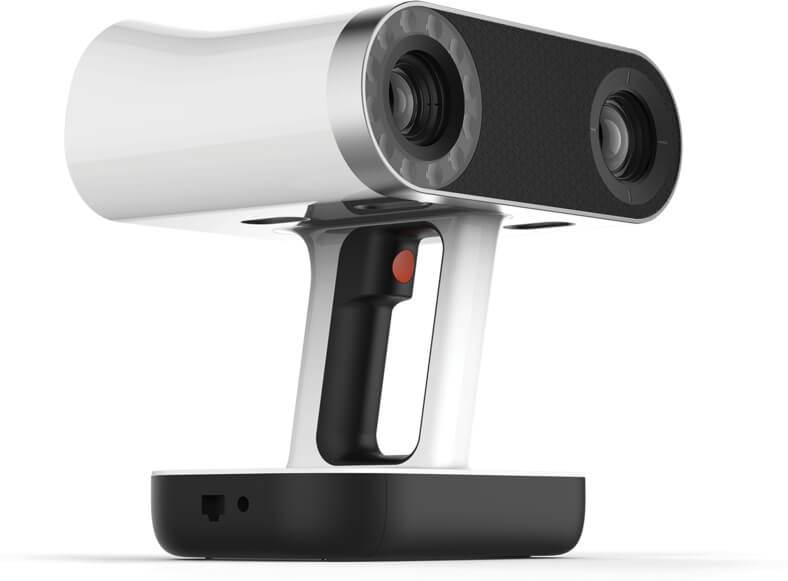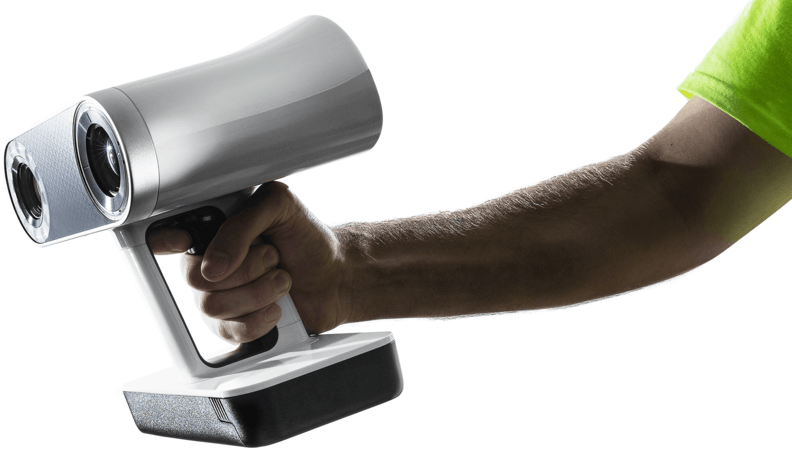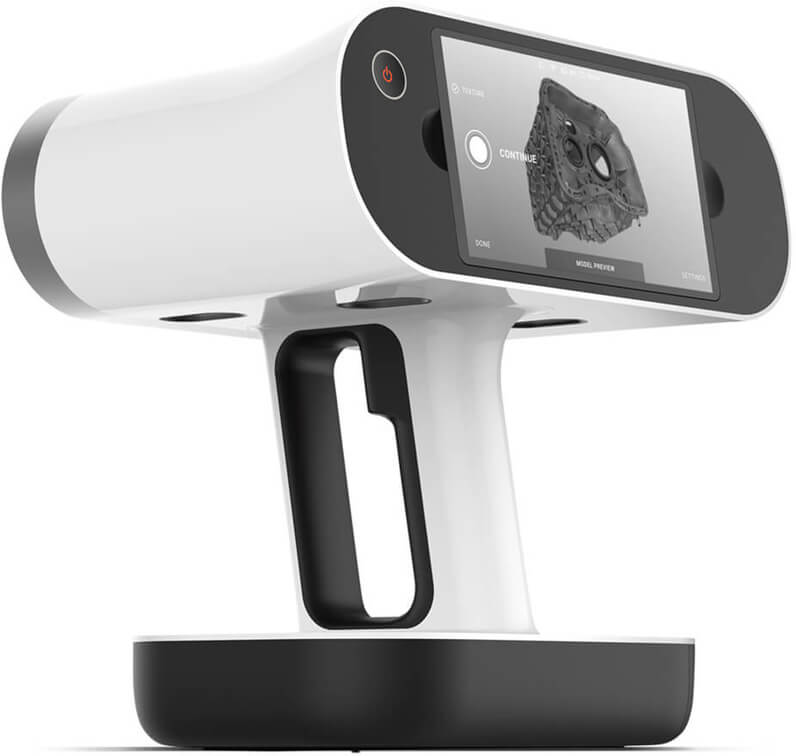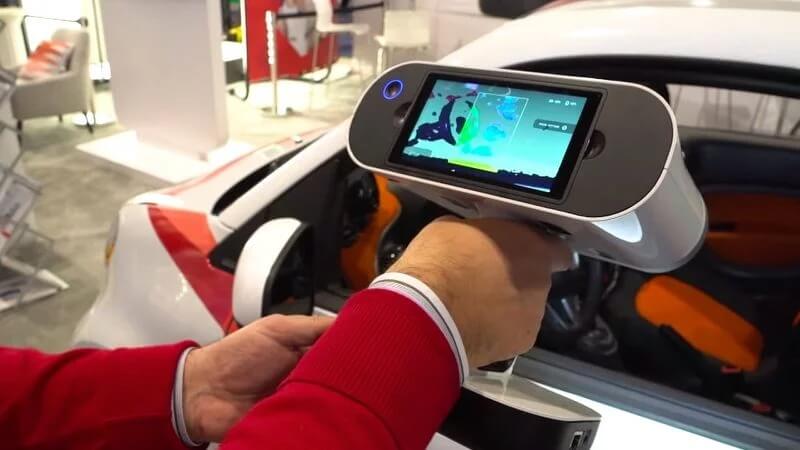Artec Leo is a professional portable 3D scanner by Artec – a scanner manufacturer based in Luxemburg. It uses structured light technology for scanning objects of varying geometries ranging from mechanical parts to people, to vehicles and environments.
The scanner is the first one to offer onboard automatic processing. It provides users with an intuitive workflow that makes 3D scanning extremely easy, almost like taking a video. While you are busy scanning the object, the touch screen shows you the end scan in real-time. How cool is that?
So, what makes the scanner so professional? Is it worth paying the cost at which it’s available? Let’s get to know by going in-depth about this machine.
Features
Below mentioned are some of the most intriguing features that separate it from the list of other scanners available in the same price range.
Unprecedented scanning speed
Artec Leo’s second 3D construction rate is 80 frames per second. This makes it the fastest handheld 3D scanner on the market currently.
Additionally, its large field of view increases the rate at which scanning of large objects and a scene is done in an accurate manner. Users can even get greater precision by the point closer to the object for picking up on intricate detailing just as they typically zoom in on a camera.
Touch screen interface
There is a large touch screen interface embedded in the body of the scanner. This provides sheer ease of use, makes operations and their control straightforward for the user.
It’s very responsive and quick. Operators can have an immediate look at the quality of their scans on the touchscreen and decide whether they wish to go with it or rescan the object.
Powerfully embedded processor
Leo is equipped with an impact-making processor and battery. Because of this, the need to have a computer or stationary power source is eliminated. It allows users to capture objects freely. The batteries can be easily swapped out as they get discharged every six hours.
High-grade technology
The scanner works using an Nvidia supercomputer module Jetson TX1 processor. It has a nine degrees of freedom inertial system consisting of an accelerometer, gyroscope, and compass. All of which allows the scanner to understand its position and surrounding to ensure a better than usual scan.
Specifications
|
Technology |
Structured Light Technology |
|
Price |
29800 $ |
|
Scan Accuracy |
0.1 mm |
|
3D Resolution |
0.2 mm |
|
Capture Zone |
0.1 mm + 0.3 mm per meter distance |
|
Working Distance |
0.35 to 1.2 m |
|
Angular Field of View |
38.5 degrees * 23 degrees |
Leo is a handheld scanner able to provide a scan accuracy of 0.1 mm and 3D resolution up to 0.2 mm. Its 3D accuracy is 0.1 mm + 0.3 mm per meter distance.
The scanner comes with an HD mode and is able to process hybrid geometry and texture tracking. Its data processing algorithms are geometry and texture-based.
The machine’s working distance ranges anywhere from 0.35 to 1.2 meters. It has a volume capture zone of 160,000 cubic centimeters. Leo’s linear field of view ranges from 244 mm * 142 mm being the closest to 838 mm * 488 mm being the farthest. The angular field of view of the scanner is 38.5 degrees * 23 degrees.
Leo has a texture resolution of 2.3 megapixels. The 3D reconstruction rate for the scanner’s real-time fusion is 22 fps, whereas its 3D video recording rate is 44 fps. Users can make use of the machine’s extremely fast data acquisition speed i.e. 35 million points per second.
The scanner’s 3D and 2D exposure times are 0.0002 seconds. Its 3D light source is VCSEL, and the 2D light source is a White 12 LED array.
The machine is integrated with 5.5 inches half HD, CTP, optional Wi-fi, Ethernet video streaming to an external device. Users can access the final file in OBJ, PLY, WRL, STL, AOP, ASC, PTX, E57, and XYZRGB formats.
Price
Artec Leo is available for $29,800.
First Impression

Leo comes in a protective case including:
- The scanner’s power cables.
- A removable battery.
- User’s manual.
Perhaps the first thing that you notice while unpacking Leo is its sleeker nature and design compared to other scanners.
When you look at it more closely, you get to see the presence of two lenses present in front of the scanner. The right one projects a grid on the object using a laser in an invisible light spectrum as in the case of the structured light scanner.
Whereas, the left lens is equipped with 12 LEDs, cameras! Moving on to the processor side, the machine is equipped with an NVIDIA Jetson TX1 platform including accelerometers, gyroscope, and compass.
Setup
Setting the scanner is relatively easy as it can be used right out of the box. All that the user needs to do is:
- Turn it On using the On/Off button.
- Connect it to the Internet.
- Accept the user license.
- Activate the product from the touch screen interface.
Note that these operations can also be done from the computer. Once these four steps are done, you can start using Leo by seeing whether the object you are intending to scan is compatible and if necessary prepare it.
Scan Type

In scanners based on structured light technology, a specific pattern of light is projected on the object that you are willing to scan.
The anomalies in the pattern are then analyzed and the properties of its surface are registered to create a detailed scan that can be used to create a detailed model.
Scan Quality

Offering two times greater resolution, Leo impresses the audience with its detailed scan quality. It’s able to process objects that couldn’t be justified with scanning before.
Software
 Credit: objective3d
Credit: objective3d
Artec Studio 15 is the name of 3D file scanning software linked with Artec Leo. Among other specialties of this software, its multi-lingual characteristics allow users with having a background of 15 different languages to use it. It can be bought by paying an annual subscription fee of $800 or a lifetime subscription fee of $2000.
Operators can also buy a 30-day trial version of this software to test before paying the subscription fees. As with other applications, this one too requires a powerful computer running on Windows 10 or above versions with an i5 or i7 processor.
The program can be run on an Auto Pilot mode, specifically designed for beginners, and allows the processing of a newly scanned file automatically.
Once a model is imported to Studio 15 this mode starts asking various questions regarding scan quality, object size, etc.
The next step comprises prompting the user to clean object of the data that isn’t a part of the final model. And the last step consists of aligning the scans. Post-processing takes place in an automated manner after the completion of all the above-mentioned three steps.
Customer Support
The Help Center of Artec offers support as well as learning to its users. The support section consists of manuals, scanning tips, and information about users. Apart from this, customers can always reach out to the company via phone or email.
Parameters Influencing Buying Decision
The main points about this scanner that is good to get a glance over before making a buying decision are mentioned below in brief.
3D Scanner Cost: Being a professional 3D scanner, Leo’s cost is obviously thought to be on a higher-end. But, its differentiation from other professional users and excellent speed, takes the cost even higher than the normal higher-end.
3D Scanner Speed: Scanning speed is where Leo steals the show completely. Artec boasts about Leo’s speed all over its website. It can scan up to 4 million points per second which is astonishing!
3D Scan Quality: Extremely detailed scanning of parts and functional prototypes can be easily achieved using this scanner.
3D Scanner Capability: Leo’s flexibility makes the user capable of using it wirelessly, efficiently, rapidly, and with minimum effort.
3D Scanner Practicality: The scanner is used for a variety of applications such as industrial manufacturing, healthcare, forensics, VR, e-commerce, etc.
3D Scanner User Expectations: Professional users in search of particularity in scanning would be happy to work with Leo. It offers the sheer bliss of being wireless around an object for six hours straight. The software works like a miracle by offering Auto Pilot mode. It lets you scan and expand your capabilities as a designer, visualizer, and creative project manager.
The Verdict
Artec Leo allows users to entirely unplug and scan objects. This ensures a completely hassle-free operation without any juggling. Also, after you are done scanning, all that needs to be done is simply sending the scans to the PC and using the software to process, edit or prepare the final file. The machine’s design makes it suitable for each kind of application.
The HD touch screen and clean software interface offer an easy yet intuitive overall experience that combines with excellent scan quality. Although being heavy in weight, the scanner offers great prospects for its customers.







